

A Beginner's Guide to Choosing Equipment for Deep-Sky Electronically-Assisted Astronomy (EAA)” Author: Brian VentrudoPublished: June 20, 2020Edited: July 22, 2021 Figure 1 – An EAA session in action on a computer screen showing an image of a globular cluster captured with a ZWO ASI224MC camera and an 85mm refractor using SharpCap. 1.
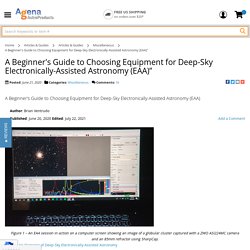
DeepSkyStacker - Free. Astrophotography: Deep Sky Stacker Tutorial. Telescopes for Astrophotography. As with picking a camera, picking the best telescope for your needs will depend on a number of different factors: Telescope Attributes - Telescopes are designed to gather light and bring it to focus so that the image can be examined in detail with an eyepiece, or recorded on film or with a digital camera.
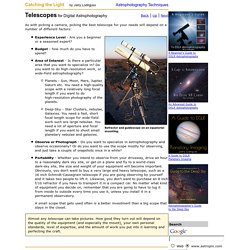
Telescopes reveal fainter objects than can be seen with the eye because they gather more photons than the eye can gather. Smaller details can be seen because they also magnify objects. The nomenclature used to describe telescopes and camera lenses can sometimes be confusing. Telescopes are usually talked about in terms of aperture, while camera lenses are usually talked about in terms of focal length. Telescopes and camera lenses have three main numerical attributes that we are concerned with in describing them: Aperture - The aperture is the size of opening in the telescope through which the lens or mirror gathers light. Optical System Types Refractive Optics In 1892 H. Reflective Optics. Astronomical CCD & Night Vision Devices. There are tradeoffs in choosing the parts of a system to do this.
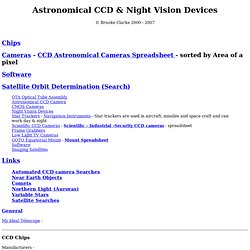
OTA Optical Tube Assembly 24 April 2005 - The KStar Telescope seems ideal for this application and probably was designed for the Air Force to do just this. It has a 5 degree FOV and uses spherical mirrors (much lower in cost than any thing but a flat mirror) and has an adjustable f number (just the thing to match the CCD array to the seeing conditins. Oceanit web page with KStar overview - pdf Brochure describing Scope - 16" model shown but could be between 250 mm and 2 m Review by the A.F.
AMOS Fall 2002 Newsletteer It's either Pat. Pend. or I can't find the patent.One of the RAVEN A.F.
Focus Masks. Focus Masks. Focus Masks Scheiner and Hartmann Masks.
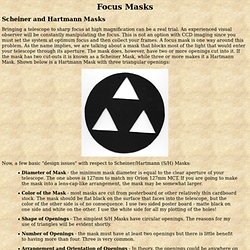
Hartmann mask template generator - Billyard Ink. Secret of the Hartmann Mask. Secret of the Hartmann Mask...

Revealed! Submitted: Tuesday, 5th April 2005 by Paul Russell Mike PMed me the other day and asked if I’d do an article on how to make a Hartmann Mask. This was a good thing as it got me off my backside during the days of my holiday, once I finished my books that is. :) So I thought while I was at it I’d do a review of the effectiveness of different hole patterns just to see which ones worked the best. The results quite surprised me. I’ve been thinking of different patterns for the Hartmann Mask lately, trying to work out what sort of pattern and hole shape would give the brightest final image with the sharpest diffraction spikes. From some of the shapes I tried I expected to get very defined diffraction spikes. Apart from the top two images using the triangular pattern, all images were done using quite high levels of gain and brightness.
Blackwater Skies: Imaging Toolbox. PHD Guiding Basic Use and Troubleshooting - Imaging - Tips, Tricks and Techniques. Pleas for help with PHD guiding seem to come up more often than almost other imaging topic.
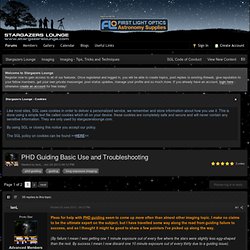
I make no claims to be the ultimate expert on the subject, but I have travelled some way along the road from guiding failure to success, and so I thought it might be good to share a few pointers I've picked up along the way. (By failure I mean I was getting one 1 minute exposure out of every five where the stars were slightly less egg-shaped than the rest. By success I mean I now discard one 10 minute exposure out of every thirty due to a guiding issue). Firstly, I am going to cover the basics of a good guiding set-up, since many problems that are blamed on PHD are actually external issues related to the equipment being used or abused.
After that I’ll take a look at how to diagnose and fix guiding problems with PHD. Why Guide? If you are imaging DSOs, you will inevitably be drawn to the idea of guiding in order to be able to make longer exposures. GuideToGuiding.pdf. TUTORIAL (IMAGING): Setting up the Orion StarShoot AutoGuider (SSAG) on a 50mm Guide Scope with Optimum PHD Guiding Settings. Tutorial Type:Imaging - Setup The Orion StarShoot AutoGuider (SSAG) and Orion 50mm Mini Guide Scope is a great auto-guiding system that comes at a relatively low price and provides extreme effectiveness: The advantages of using this system are clear and include the following: 1.
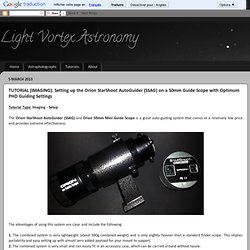
The combined system is very lightweight (about 590g combined weight) and is only slightly heavier than a standard finder scope. This implies portability and easy setting up with almost zero added payload for your mount to support. 2. 3. 4. 5. 6. Dave Trott - Double Arm Barn Door. Shoot 'N Dither - Lumen Antiquus Apps. Shoot 'N Dither (SND) provides the astrophotographer a means of scheduling and executing an imaging session.
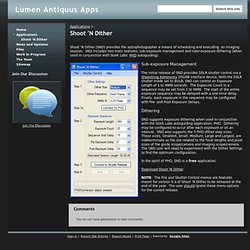
SND includes two main features; sub-exposure management and inter-exposure dithering (when used in conjunction with Stark Labs' PHD autoguiding). Sub-exposure Management The initial release of SND provides DSLR shutter control via a Shoestring Astronomy DSUSB interface device. With the DSLR shutter mode set to BULB, SND can control an Exposure Length of 1 to 9999 seconds. The Exposure Count in a sequence may be set from 1 to 9999. Dithering SND supports exposure dithering when used in conjunction with the Stark Labs autoguiding application, PHD.